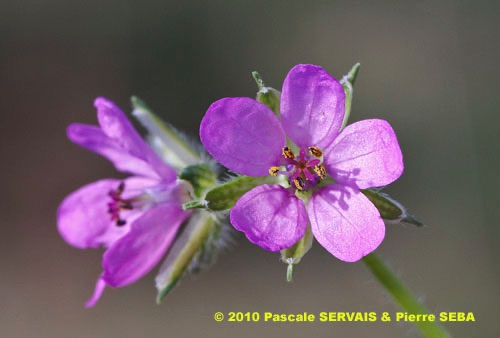
Erodium cicutarium (L.) L’Hér.
Fam. : Geraniaceae
© Pascale SERVAIS & Pierre SEBA, 2018. Tilo Botanica: Flore de Tilos et du Dodécanèse / Flora of Tilos and of the Dodecanese
English translation by Brenda Bradbury, Howard Bradbury and Stéphane Léonard
Plante herbacée, hermaphrodite, à tiges d’abord presque nulles, puis allongées, dressées, étalées ou prostrées, articulées, velues.
Feuilles alternes, composées imparipennées (au moins les inférieures), poilues, à 2 à 8 paires de folioles dentées, divisées sur plus de la moitié du limbe, sans petites folioles entre les folioles principales.
Fleurs à symétrie radiaire, rose pourpré, lilas ou blanches, de 10 à 18 mm de diamètre, réunies par 4 à 12 en ombelles de ± 3 cm de diamètre. Corolle à 5 pétales libres, obovales, les 2 supérieurs souvent plus grands. Calice à 5 sépales libres, poilus, vert clair avec une ligne plus foncée. 1 style mauve à 5 stigmates. 5 étamines fertiles à filet mauve et à anthère mauve et 5 étamines sans anthère. Ovaire supère.
Fruits, capsules velues. Méricarpes à poils appliqués avec 1 alvéole peu profonde et sans glandes au sommet. Bec de 20 à 50 mm de long.
___________________________
Plant herbaceous, hermaphrodite. Stems first almost null, then lengthened, erect, spread out or procumbent, divided in very hairy articles.
Leaves alternate, compound imparipinnate (at least the inferior ones), hairy, with 2 to 8 pairs of toothed leaflets, divided on more than half of the blade, without small leaflets between the main leaflets.
Flowers radially symmetrical, purplish pink, lilac or white, from 10 to 18 mm in diameter, joined together by 4 to 12 in umbels ± 3 cm in diameter. Corolla with 5 free, obovate petals, the 2 upper ones often taller. Calyx with 5 free sepals, hairy, pale green with a darker line. 1 mauve style with 5 stigmas. 5 fertile stamens with a mauve filament and a mauve anther and 5 stamens without an anther. Ovary superior.
Fruits, very hairy capsules. Mericarps with appressed hairs and with a shallow hollow without glands at the top. Beak from 20 to 50 mm long.
Descripteurs / Identifying features
1
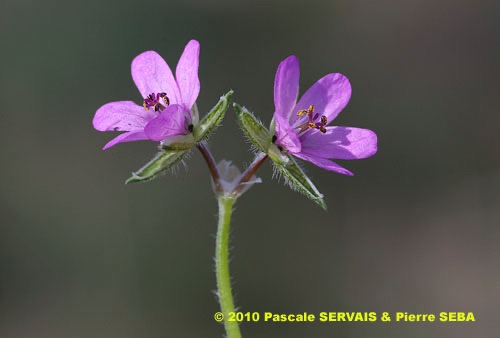
2
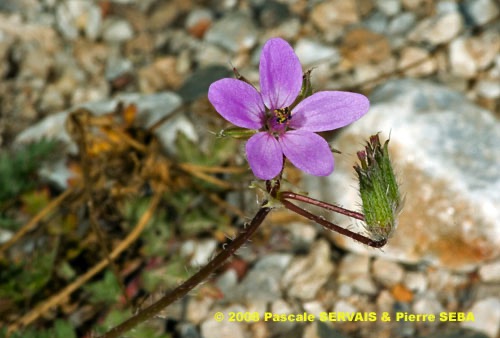
3
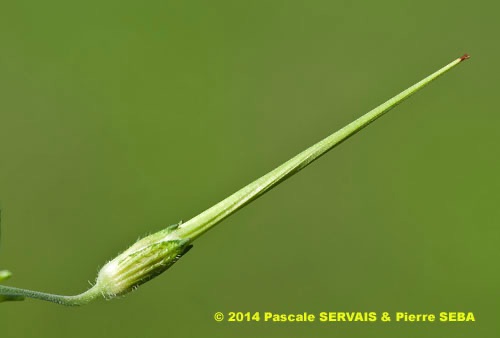
4
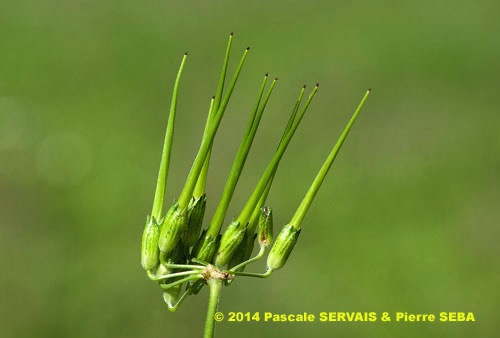
5
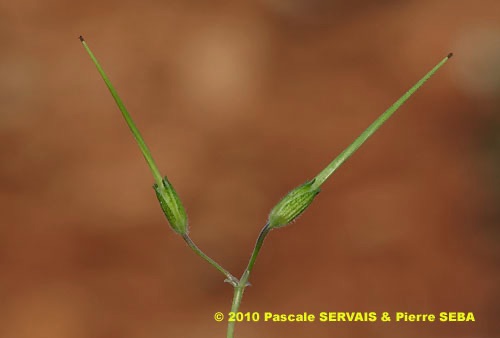
6
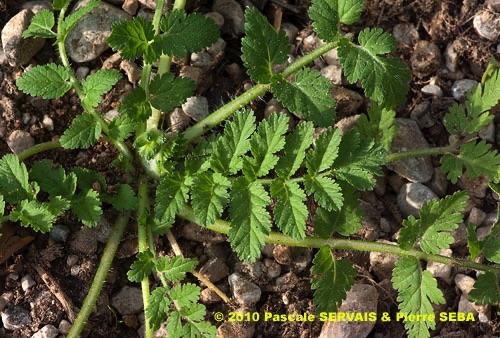
7
Étymologie / Etymology :
Erodium : emprunt du grec ancien ἐρῳδιός, -οῦ (nom) = le héron,
en référence au fruit surmonté d’un long bec.
Cicutarium : emprunt du latin cicutarius, -a, -um (adj.)
[ < cicuta, -ae (nom) = la ciguë ] = qui a l’apparence de la ciguë,
en référence à la forme des feuilles.
Erodium : borrowed from Classical Greek ἐρῳδιός, -οῦ (noun) = heron,
referring to the fruit surmounted by a long beak.
Cicutarium : borrowed from Latin cicutarius, -a, -um (adj)
[ < cicuta, -ae (noun) = hemlock ] = which has the appearance of
hemlock, referring to the shape of the leaves.
Synonyme / Synonym :
Geranium cicutarium L.
Noms vernaculaires / Common names :
Noms français / French names :
Bec-de-grue à feuilles de ciguë — Cicutaire —
Érodium à feuilles de ciguë — Érodium commun.
Noms grecs / Greek names :
Βελανίδα — Βελονάκι — Βελονιά — Βελονόχορτο — Ερωδιός —
Καλόγερος — Καλόγηρος — Περδικονύχι — Πηρούνι — Πιρουνάκι —
Χτενάκι.
Noms anglais / English names :
Common stork’s bill — Redstem filaree — Redstem stork’s bill —
Stork’s bill.
Noms allemands / German names :
Gemeiner Reiherschnabel — Gewöhnlicher Reiherschnabel —
Schierlings Reiherschnabel — Schierlings-Reiherschnabel.
Noms espagnols / Spanish names :
Aguja de pastor — Aguja de vaquero — Alfilerillo de pastor —
Cigüeña — Peine de bruja — Peine de Venus.
Noms italiens / Italian names :
Becco di grù comune — Cicutaria.
Habitat :
Lieux pierreux - Lieux incultes - Sols sableux - Chemins - Murs, rochers.
Stony places - Waste ground - Sandy soils - Waysides - Walls, rocks.
Île / Island :
Tilos.
Hauteur / Height range :
De 5 cm à 50 cm.
From 5 cm to 50 cm.
Floraison / Flowering time :
De novembre à juillet.
From November to July.
Groupe / Classification :
Dicotylédones.
Dicotyledons.
Pérennité / Lifespan :
Annuelle.
Annual.
Description :
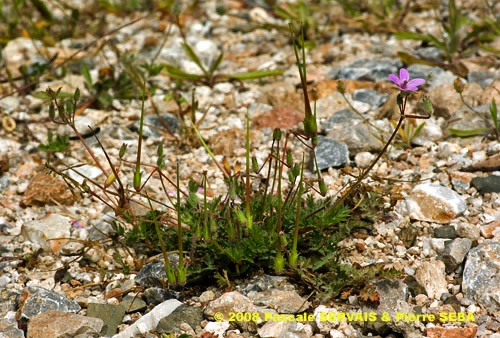
8
Clés dichotomiques et descripteurs distinctifs des 6 espèces / Dichotomous keys and distinctive identifying features of the 6 species
Photo 1 :
Localisation / Location : Tilos, Livadia, Village
Date : 30/11/2010
GPS : Lat. 36,41299° N / Long. 27,38510° E / Alt. 12 m
Type : Photographie numérique / Digital Photograph (10 mégapixels)
Photo 2 :
Localisation / Location : Tilos, Livadia, Village
Date : 30/11/2010
GPS : Lat. 36,41299° N / Long. 27,38510° E / Alt. 12 m
Type : Photographie numérique / Digital Photograph (10 mégapixels)
Photo 3 :
Localisation / Location : Tilos, Livadia, Village
Date : 13/04/2008
GPS : Lat. 36,41299° N / Long. 27,38510° E / Alt. 12 m
Type : Photographie numérique / Digital Photograph (10 mégapixels)
Photo 4 :
Localisation / Location : Tilos, Livadia, Village
Date : 10/02/2014
GPS : Lat. 36,41299° N / Long. 27,38510° E / Alt. 12 m
Type : Photographie numérique / Digital Photograph (10 mégapixels)
Photo 5 :
Localisation / Location : Tilos, Livadia, Village
Date : 10/02/2014
GPS : Lat. 36,41218° N / Long. 27,38759° E / Alt. 3 m
Type : Photographie numérique / Digital Photograph (10 mégapixels)
Photo 6 :
Localisation / Location : Tilos, Livadia, Village
Date : 03/12/2010
GPS : Lat. 36,41299° N / Long. 27,38510° E / Alt. 12 m
Type : Photographie numérique / Digital Photograph (10 mégapixels)
Photo 7 :
Localisation / Location : Tilos, Livadia, Village
Date : 30/11/2010
GPS : Lat. 36,41299° N / Long. 27,38510° E / Alt. 12 m
Type : Photographie numérique / Digital Photograph (10 mégapixels)
Photo 8 :
Localisation / Location : Tilos, Livadia, Village
Date : 13/04/2008
GPS : Lat. 36,41299° N / Long. 27,38510° E / Alt. 12 m
Type : Photographie numérique / Digital Photograph (10 mégapixels)

Google Maps
Google Maps
Google Maps
Google Maps
Google Maps
Google Maps
Google Maps
Google Maps